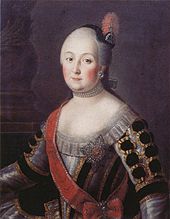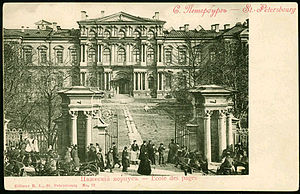- Mikhail Illarionovich Vorontsov
-
Count Mikhail Illarionovich Vorontsov (Russian: Михаи́л Илларио́нович Воронцо́в) (July 12, 1714 – February 15, 1767) was a Russian statesman and diplomat, who laid foundations for the fortunes of the Vorontsov family.
At the age of fourteen, Vorontsov was appointed a kammerjunker at the court of the tsesarevna Yelizaveta Petrovna, whom he materially assisted during the famous coup d'etat of December 6, 1741, when she mounted the Russian throne on the shoulders of the Preobrazhensky Grenadiers. On January 3, 1742, Vorontsov married countess Anna Karlovna Skavronskaya, the empress's maternal first cousin, and in 1744 was created a count and vice-chancellor. His jealousy of Aleksei Petrovich Bestuzhev-Ryumin induced him to participate in Count Lestocq's conspiracy against that statesman. The empress's affection for him (she owed much to his skilful pen and still more to the liberality of his rich kinsfolk) saved him from the fate of his accomplices, but he lived in a state of semi-eclipse during the domination of Bestuzhev.
On the disgrace of Bestuzhev, Vorontsov was made imperial chancellor in his stead. Though well-meaning and perfectly honest, Vorontsov as a politician was singularly timorous and irresolute, and always took his cue from the court. Thus, under Yelizaveta Petrovna he was an avowed enemy of Prussia and a warm friend of Austria and France; yet he made no effort to prevent Peter III from reversing the policy of his predecessor. Yet, he did not lack personal courage, and endured torture after the revolution of July 9, 1762, rather than betray his late master. Having promoted his niece Elizabeth as a favourite mistress of Peter III, he naturally greatly disliked his wife Catherine, and at first refused to serve under her, though she reinstated him in the dignity of chancellor. When he found that the real control of foreign affairs was in the hands of Nikita Panin, he resigned his office in 1763.
Mikhail Voronzov may be said to have revived the fortunes of his ancient and illustrious family. His name is preserved in the lavish St Petersburg palace he commissioned to the imperial architect Bartolomeo Rastrelli. He squandered most of his personal fortune upon that edifice but was subsequently constricted to sell it to the crown for the lack of funds required to complete its interior decoration. His niece Catherine was on intimate terms with her royal namesake, and his nephew Alexander Romanovich Vorontsov likewise attained the dignity of imperial chancellor in the early years of Alexander I's reign.
References
 This article incorporates text from a publication now in the public domain: Chisholm, Hugh, ed (1911). Encyclopædia Britannica (11th ed.). Cambridge University Press.
This article incorporates text from a publication now in the public domain: Chisholm, Hugh, ed (1911). Encyclopædia Britannica (11th ed.). Cambridge University Press.
External links
Categories:- Foreign Ministers of Russia
- Russian nobility
- Recipients of the Order of the White Eagle (Poland)
- Recipients of the Order of the Black Eagle
- 1714 births
- 1767 deaths
- 18th-century Russian people
- Recipients of the Order of St. Andrew
Wikimedia Foundation. 2010.



